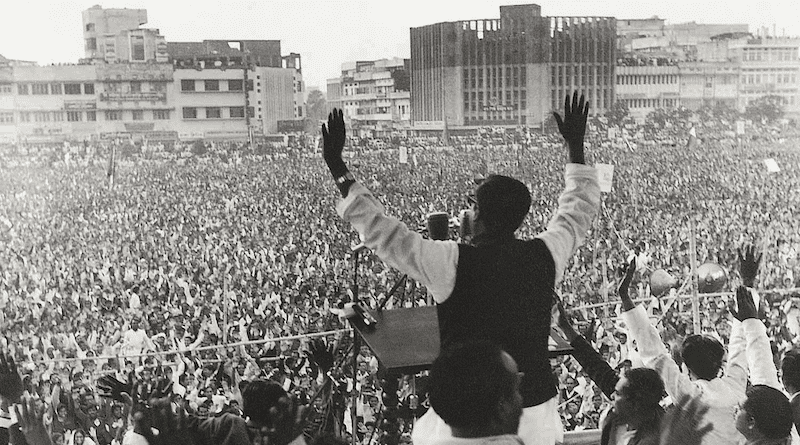Revisiting The Agartala Conspiracy – OpEd
By Moiz Khan
During General Ayub’s rule in Pakistan in the 1960s, the government brought to the surface the Agartala Conspiracy Case, which indicted the leader of the Awami League, Sheikh Mujibur Rahman, as well as current and former members of the armed forces and other high-ranking government officials in high treason. They were suspected of plotting to split off Pakistan’s eastern province with the assistance of the Indian government.
The petition’s petitis principle alleged that the accused and the Indians hatched the plot in the city of Agartala, Tripura, India, hence, the case name. After the war in 1965, East-West Pakistan ties deteriorated steadily. Once in control of Pakistan, Ayub Khan’s influence started to wane. Strikes and rioting were commonplace in the Eastern Wing, which had previously shown lesser agitation.
The inhabitants of East Pakistan have had their legal rights violated since Pakistan was founded. As a result, they began to feel animosity against their country’s authorities in Pakistan. With this in mind, the people of East Pakistan overzealously started to support Sheikh Mujibur Rahman and the Awami League’s demand for autonomy as outlined in Mujib’s six-point plan. Sheikh Mujib hatched the plan to spark an armed uprising against West Pakistan and bring about the breakaway. Mujibur Rahman, a naval steward, and Mohammad Ali Reza, a teacher, are two of the accused who traveled to the city of Agartala in the Indian state of Tripura in the hopes of gaining Indian support for an independent Bangladesh. Lieutenant Colonel Shamsul Alam, who was in charge of the East Pakistan Detachment of the Inter-Services Intelligence, is credited with uncovering the purported plot (ISI).
Around this time, East Bengal Regiment officer Rauf ur Rahman, who was in cahoots with the conspirators, attempted to assassinate Alam. The later protected himself from the would-be killers, earning himself the Sitara-e-Basalat, the nation’s highest honour for valour during times of peace. The Home Department of Pakistan said that it had identified a strategy to destabilize Pakistan and split the Eastern wing via an armed uprising in January 1968, and had detained 8 persons in connection with the plot that had begun in 1967, leading to the arrest of Bengalis. A popular uprising (when and how: add details) in East Pakistan, however, forced the Pakistani government to drop the charges.
The press-note announced the arrest of eight people, two of whom were CSP personnel, who were claimed to be plotting an armed uprising to split East Pakistan from the rest of the country. A supplementary statement published by the Home Department on January 18, 1968, accused Sheikh Mujibur Rahman as the master mind of the plot. His detention in prison began on May 9, 1966, when he was one of several people who had been held there since that day. Even after being released, they were promptly re-arrested for violating martial law and sent to Dhaka Cantonment.
The Agartala Conspiracy, a plot with far-reaching consequences for Pakistan, determined the course of future events. The release of Sheikh Mujib was widely criticized as a disastrous misstep that trivialized the seriousness of the underlying plot. But if you look at the context closely, you’ll see the whole picture. India, like any cunning foe, plotted to undermine Pakistan. East of Bengal, in the Indian state of Tripura, is where you’ll find the city of Agartala.
In December 1967, it was uncovered that several Bengali politicians, public employees, and military personnel were in communication with Indian authorities, reportedly to assassinate Ayub Khan, overthrow the government, and free a region to form an independent state in East Pakistan. Some of the Indians involved were eventually revealed to be First Secretary P.N.Ojha of the Indian High Commission, Lieutenant Colonel Misra, and Major Menon. Considering the public’s awareness of India’s ties to East Pakistani leaders, this shouldn’t come as a surprise. In retrospect, even Mujib recognized that he had spoken with Indians.
There are two indisputable pieces of evidence. The book by ex-RAW agent Ashoka Raina is one example. The Agartala plot is explicitly referenced in his book, Inside RAW. The sheer validity of the plot is attested to by a comment from Mrs. Kohinoor Hussain, the wife of Lt. Commander Moazzam Hussain. First Secretary of the Indian Embassy, and other Indian and Bangladeshi officials at the Agartala border crossing. While turning over command of 14 Division to Major General Khadim Hussain Raja, Major General Muzaffaruddin gave a brief summary of the Agartala plot before passing the baton to his successor. “Sheikh Mujib Ur Rehman was legitimately implicated,” Muzaffaruddin said to Khadim. The plan called for certain Bengali soldiers to execute nighttime surprise assaults against West Pakistani military units’ quarter guards and armories. These squads would be disarmed and held as prisoners of war in the barracks. With help from the Indian government, we can prevent West Pakistani planes from flying over us. There is a mountain of evidence supporting this plot.
The approach used, however, was less than ideal. It’s true that Mujib was a renowned person, but bringing charges against him when he was already behind bars gave the situation an odd air. His involvement in the case led to his release and the dropping of the charges. But there were good reasons to free Mujib, and that made him the uncontested leader of East Pakistan.
Moiz Khan has completed his Mphil in Media Sciences from Riphah International University. He is interested in military history, International politics and political economy.

